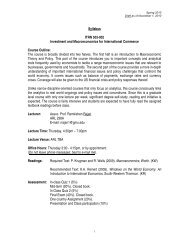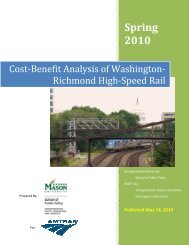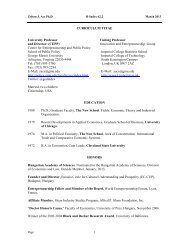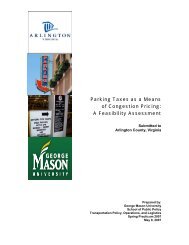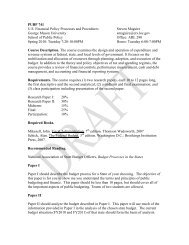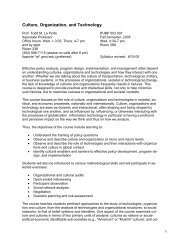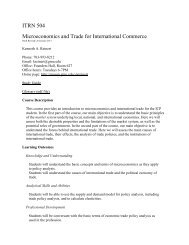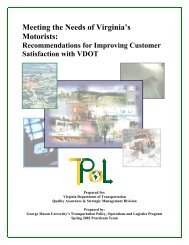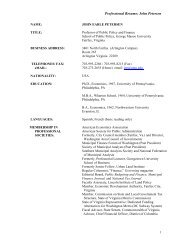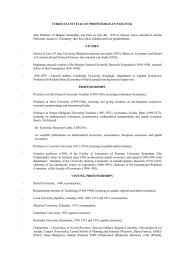Net Assessment and Planning for National Security - George Mason ...
Net Assessment and Planning for National Security - George Mason ...
Net Assessment and Planning for National Security - George Mason ...
Create successful ePaper yourself
Turn your PDF publications into a flip-book with our unique Google optimized e-Paper software.
Meeting Time: Monday, 4:30PM-7:10 PM<br />
Location: Arlington 331<br />
DRAFT<br />
<strong>George</strong> <strong>Mason</strong> University<br />
School of Public Policy<br />
<strong>Net</strong> <strong>Assessment</strong> <strong>and</strong><br />
<strong>Planning</strong> <strong>for</strong> <strong>National</strong> <strong>Security</strong><br />
PUBP 710-002<br />
Spring 2008<br />
Andrew F. Krepinevich<br />
Office Hours: 3:30-4:30 PM, Mondays, <strong>and</strong> by appointment<br />
Office:<br />
Telephone: 202-331-7990 (ext. 1345)<br />
Email: Krepinevich@csbaonline.org<br />
Course Objective<br />
The course examines <strong>Net</strong> <strong>Assessment</strong>; a multidisciplinary strategic assessment process<br />
developed to address security issues, including military balance assessments. <strong>Net</strong><br />
<strong>Assessment</strong> involves a many-sided comparative evaluation of the balance of strengths<br />
<strong>and</strong> weaknesses of countries, <strong>and</strong> regional <strong>and</strong> institutional entities of interest to national<br />
security decision-makers. Eclectic in scope, <strong>Net</strong> <strong>Assessment</strong> involves myriad elements,<br />
addressing political, military, social, cultural, demographic, economic, budgetary,<br />
ecological, <strong>and</strong> technological influences on the security environment. While it employs<br />
st<strong>and</strong>ard political science methodologies, <strong>Net</strong> <strong>Assessment</strong> often involves the use of<br />
business principles, scenarios, so-called crisis <strong>and</strong> path gaming, conflict simulations, <strong>and</strong><br />
other analytic tools. Properly applied, the <strong>Net</strong> <strong>Assessment</strong> process can assist the policy<br />
maker in identifying current strategic relationships <strong>and</strong>, perhaps equally important, where<br />
the security competition is headed <strong>and</strong> what factors will be most important in determining<br />
future military balances. Included in the course will be the application of <strong>Net</strong> <strong>Assessment</strong><br />
principles to several historical <strong>and</strong> contemporary case studies, to include the military<br />
balance in Western Europe in the spring of 1940, the NATO-Warsaw Pact military<br />
balance, the Anglo-German Dreadnought race, the current defense program being crafted<br />
from the Quadrennial Defense Review, <strong>and</strong> the emerging Military Revolution.<br />
DRAFT
Graded Requirements (Percentage of Grade)<br />
Mid-Term Exam (40%)<br />
Class Participation (This class is a seminar; in<strong>for</strong>med participation is expected) (20%)<br />
Research Paper* (20-30 pages, double-spaced with citations) (40%)<br />
(Late submissions will not be accepted)<br />
*New Voices in Public Policy: I will consider nominating the very best papers in this<br />
course <strong>for</strong> publication in New Voices in Public Policy. New Voices is a student- <strong>and</strong><br />
faculty-reviewed journal that shares SPP's finest student work with the rest of the world.<br />
Special Needs<br />
If you are a student with a disability <strong>and</strong> you need academic accommodations, please see<br />
me <strong>and</strong> contact the Disability Resource Center (DRC) at 993-2474. All academic<br />
accommodations must be arranged through the DRC.<br />
SPP Policy on Plagiarism<br />
The profession of scholarship <strong>and</strong> the intellectual life of a university as well as the field<br />
of public policy inquiry depend fundamentally on a foundation of trust. Thus any act of<br />
plagiarism strikes at the heart of the meaning of the university <strong>and</strong> the purpose of the<br />
School of Public Policy. It constitutes a serious breach of professional ethics <strong>and</strong> it is<br />
unacceptable.<br />
Plagiarism is the use of another’s words or ideas presented as one’s own. It includes,<br />
among other things, the use of specific words, ideas, or frameworks that are the product<br />
of another’s work. Honesty <strong>and</strong> thoroughness in citing sources is essential to professional<br />
accountability <strong>and</strong> personal responsibility. Appropriate citation is necessary so that<br />
arguments, evidence, <strong>and</strong> claims can be critically examined.<br />
Plagiarism is wrong because of the injustice it does to the person whose ideas are stolen.<br />
But it is also wrong because it constitutes lying to one’s professional colleagues. From a<br />
prudential perspective, it is shortsighted <strong>and</strong> self-defeating, <strong>and</strong> it can ruin a professional<br />
career.<br />
The faculty of the School of Public Policy takes plagiarism seriously <strong>and</strong> has adopted a<br />
zero tolerance policy. Any plagiarized assignment will receive an automatic grade of “F.”<br />
This may lead to failure <strong>for</strong> the course, resulting in dismissal from the University. This<br />
dismissal will be noted on the student’s transcript. For <strong>for</strong>eign students who are on a<br />
university-sponsored visa (eg. F-1, J-1 or J-2), dismissal also results in the revocation of<br />
their visa.<br />
2
To help en<strong>for</strong>ce the SPP policy on plagiarism, all written work submitted in partial<br />
fulfillment of course or degree requirements must be available in electronic <strong>for</strong>m so that<br />
it can be compared with electronic databases, as well as submitted to commercial services<br />
to which the School subscribes. Faculty may at any time submit student’s work without<br />
prior permission from the student. Individual instructors may require that written work be<br />
submitted in electronic as well as printed <strong>for</strong>m. The SPP policy on plagiarism is<br />
supplementary to the <strong>George</strong> <strong>Mason</strong> University Honor Code; it is not intended to replace<br />
it or substitute <strong>for</strong> it.<br />
Texts:<br />
Williamson Murray <strong>and</strong> Allan R. Millet. Military Innovation in the Interwar<br />
Period (London: Cambridge University Press, 1996).<br />
PART I. INTRODUCTION & TOOLS OF THE TRADE<br />
1. What is <strong>Net</strong> <strong>Assessment</strong>? (Jan 21)<br />
Eliot A. Cohen. “<strong>Net</strong> <strong>Assessment</strong>: An American Approach,” (Tel Aviv: JCSS<br />
Memo #29, April 1990), unpublished paper.<br />
A.W. Marshall, J.J. Martin, <strong>and</strong> Henry S. Rowan, eds. On Not Confusing<br />
Ourselves (Boulder, CO: Westview Press, 1991). Hereafter cited as<br />
“ONCO.” Chapters 9 <strong>and</strong> 15.<br />
A.W. Marshall. Problems of Estimating Military Power. (Santa Monica, CA:<br />
R<strong>and</strong> Corporation, 1966). (Instructor PDF)<br />
A. W. Marshall, “The Nature <strong>and</strong> Scope of <strong>National</strong> <strong>Net</strong> <strong>Assessment</strong>,” draft<br />
<strong>National</strong> <strong>Security</strong> Council memor<strong>and</strong>um, March 26, 1972, pp. 1-12. (Instructor<br />
pdf.)<br />
A. W. Marshall, “The Nature <strong>and</strong> Scope of <strong>Net</strong> <strong>Assessment</strong>s,” <strong>National</strong> <strong>Security</strong><br />
Council memor<strong>and</strong>um, August 16, 1972, pp. 1-3. (Instructor pdf.)<br />
Henry Mintzberg, “The Fall <strong>and</strong> Rise of Strategic <strong>Planning</strong>,” Harvard Business<br />
Review (hereafter cited as “HBR”) (January-February 1994).<br />
Jay Winik, “Secret Weapon,” The Washingtonian (April 1999). (Instructor pdf)<br />
2. Crafting a <strong>Net</strong> <strong>Assessment</strong>: The Case of China (Jan 28)<br />
Roger Cliff, et al., Entering the Dragon’s Lair (Santa Monica, CA: RAND,<br />
2007). (Instructor pdf)<br />
3
Aaron Friedberg, “The Struggle <strong>for</strong> Mastery in Asia,” Commentary, November<br />
2000.<br />
(R) Andrew Krepinevich, et. Al., Meeting the Anti-Access <strong>and</strong> Area-Denial<br />
Challenge (Washington, DC: CSBA, 2003).<br />
(R) “The Assassin’s Mace: China’s Growing Military Might,” The New Atlantis,<br />
2004, pp. 107-110.<br />
3. Static <strong>and</strong> Dynamic Measures, <strong>and</strong> Scenario-Based <strong>Planning</strong> (Feb 4)<br />
Alan Beyerchen. “Clauswitz, Nonlinearity, <strong>and</strong> the Unpredictability of War,”<br />
International <strong>Security</strong> (hereafter cited as “IS”) (Winter 1992/93).<br />
Hugh Courtney, Jane Kirkl<strong>and</strong>, <strong>and</strong> Patrick Viguerie. “Strategy Under<br />
Uncertainty,” HBR (November-December 1997).<br />
John W.R. Lepingwell. “The Laws of Combat?” IS (Summer, 1987).<br />
Pierre Wack. “Scenarios: Uncharted Waters Ahead,” in HBR (September-<br />
October 1985).<br />
Pierre Wack. “Scenarios: Shooting the Rapids,” in HBR (November-<br />
December 1985).<br />
4. Business Tools: Competitive Advantage, Time-Based Competition <strong>and</strong><br />
Competitive Strategies (Feb 11)<br />
W. Cockell, et al. Core Competencies <strong>and</strong> Other Business Concepts <strong>for</strong> Use in<br />
DoD Strategic <strong>Planning</strong> (San Diego, CA; SAIC, February 7, 1992).<br />
Kathleen M. Eisenhardt <strong>and</strong> Shona L. Brown. “Time Pacing: Competing in<br />
Markets that Won’t St<strong>and</strong> Still,” HBR (March-April 1998).<br />
A.W. Marshall. “Competitive Strategies: History <strong>and</strong> Background,” Unpublished<br />
paper, March 1988.<br />
Michael E. Porter. “The Competitive Advantage of Nations,” HBR (March-<br />
April 1990).<br />
C.K. Prahalad <strong>and</strong> Gary Hamel. “The Core Competence of the Corporation,”<br />
HBR (May-June 1990).<br />
<strong>George</strong> Stalk. “Time—The Next Source of Competitive Advantage,” HBR<br />
(July-August 1988).<br />
4
Barry Watts, “Relative Cost Imposition as a <strong>Net</strong> <strong>Assessment</strong> Topic <strong>for</strong> DHS,”<br />
Unpublished draft paper, November 6, 2007.<br />
5. Measures of Effectiveness: Six Case Studies (Feb 18)<br />
Thomas A. Keaney <strong>and</strong> Eliot A. Cohen. Revolution in Warfare? Air Power in<br />
the Persian Gulf (Annapolis, MD: Naval Institute Press, 1995), pp. 45-79.<br />
Andrew F. Krepinevich. The Army <strong>and</strong> Vietnam (Baltimore: The Johns Hopkins<br />
University Press, 1986), pp. 3-16, 157-163, 194-233, 258-275.<br />
Andrew F. Krepinevich. “Are We Winning in Iraq?” Testimony, United States<br />
House of Representatives, Committee on Armed Services, March 17, 2005.<br />
James G. Roche <strong>and</strong> Barry D. Watts. “Choosing Analytic Measures,” The<br />
Journal of Strategic Studies (June 1991).<br />
6. Military Effectiveness: The Dynamics of Innovation <strong>and</strong> Trans<strong>for</strong>mation<br />
(Feb 25)<br />
Joseph L. Bower <strong>and</strong> Clayton M. Chistensen. “Disruptive Technologies:<br />
Catching the Wave,” HBR (January-February 1995).<br />
John P. Kotter. “Leading Change: Why Trans<strong>for</strong>mation Ef<strong>for</strong>ts Fail,” HBR<br />
(March-April 1995).<br />
Andrew F. Krepinevich. “Why No Trans<strong>for</strong>mation?” Joint Forces Quarterly<br />
(Autumn-Winter 1999-2000).<br />
7. Case Study: Military Trans<strong>for</strong>mation in the Interwar Period (Mar 3)<br />
Williamson Murray. “Armored Warfare: The British, French, <strong>and</strong> German<br />
Experiences,” in Williamson Murray <strong>and</strong> Allan R. Millet, eds., Military<br />
Innovation in the Interwar Period (Hereafter cited as “MIIP”) (London:<br />
Cambridge University Press, 1996).<br />
Geoffrey Till. “Adopting the Aircraft Carrier: The British, American, <strong>and</strong><br />
Japanese Case Studies,” in Williamson Murray <strong>and</strong> Allan R. Millet, eds., MIIP.<br />
Barry Watts <strong>and</strong> Williamson Murray. “Military Innovation in Peacetime,” in<br />
Williamson Murray <strong>and</strong> Allan R. Millet, MIIP.<br />
Andrew F. Krepinevich. Lighting the Path Ahead (Washington, DC: CSBA,<br />
2002). (Instructor pdf)<br />
5
Spring Break (Mar 10)<br />
8. Mid-Term Examination (Mar 17)<br />
PART II: HISTORICAL CASE STUDIES<br />
9. The Military Balance: France 1940 (Mar 24)<br />
Eliot A. Cohen <strong>and</strong> John Gooch. Military Mis<strong>for</strong>tunes (New York: Free Press,<br />
1990), Chapter 8.<br />
Philip A. Karber, et al. Assessing the Balance of Forces: France 1940. (McLean,<br />
VA: BDM Corporation, June 18, 1979).<br />
Ernest R. May. Strange Victory (New York: Hill <strong>and</strong> Wang, 2000), pp. 448-64.<br />
Williamson Murray. The Change in the European Balance of Power, 1938-<br />
39. (Princeton, N.J.: Princeton University Press, 1984), Chapters X <strong>and</strong> XI.<br />
10. The NATO-Warsaw Pact Military Balance (Mar 31)<br />
Eliot A. Cohen. “Toward Better <strong>Net</strong> <strong>Assessment</strong>,” IS (Summer 1988).<br />
John J. Mearsheimer. “Numbers, Strategy, <strong>and</strong> the European Balance,” IS<br />
(Spring 1988).<br />
Joshua M. Epstein. “Dynamic Analysis <strong>and</strong> the Conventional Balance in<br />
Europe,” IS (Spring 1988).<br />
Barry R. Posen. “Is NATO Decisively Outnumbered?” IS (Spring 1988).<br />
11. The Anglo-German Dreadnought Race (Apr 7)<br />
Aaron L. Friedberg. The Weary Titan: Britain <strong>and</strong> the Experience of Relative<br />
Decline (Princeton, N.J.: Princeton University Press, 1988), Chapter 4.<br />
Nicholas A. Lambert. “Admiral John Fisher <strong>and</strong> the Concept of Flotilla Defence,<br />
1904-1909,” The Journal of Military History (October 1995).<br />
Nicholas A. Lambert. “British Naval Policy, 1913-1914: Financial Limitation<br />
<strong>and</strong> Strategic Revolution,” The Journal of Modern History (September 1995).<br />
John Tetsuro Sumida, “Sir John Fisher <strong>and</strong> the Dreadnought: The Sources of<br />
Naval Mythology,” The Journal of Modern History (October 1995).<br />
12. The U.S.-Soviet Strategic-Nuclear Balance (Apr 14)<br />
6
A. W. Marshall, “The Future of the Strategic Balance,” OSD/NA memor<strong>and</strong>a,<br />
August 1976. (Instructor pdf.)<br />
Bruce W. Bennett, Assessing the Capabilities of Strategic Nuclear Forces: The<br />
Limits of Current Methods (Santa Monica, CA: RAND, June 1980, N-1441-NA,<br />
unclassified, pp. 1-32, 54-83, 94-112. (Instructor pdf.)<br />
Herman Kahn, Thinking about the Unthinkable (1962), pp. 1-38, 212-217.<br />
(Instructor pdf.)<br />
Herman Kahn, Thinking about the Unthinkable in the 1980s (New York: Simon &<br />
Schuster, 1984), pp. 23-53.<br />
Keith B. Payne, The Fallacies of Cold War Deterrence <strong>and</strong> a New Direction<br />
(Lexington, KY: University Press of Kentucky, 2001), pp. 17-78.<br />
PART III: THE FUTURE OF NET ASSESSMENT<br />
13. The Military Revolution (Apr 21)<br />
Andrew F. Krepinevich. “Cavalry to Computer: The Patterns of Military<br />
Revolutions,” The <strong>National</strong> Interest (Fall 1994).<br />
Andrew F. Krepinevich, The Military-Technical Revolution Revolution: A<br />
Preliminary <strong>Assessment</strong> (Washington, DC: CSBA, 2002).<br />
A. W. Marshall, “Some Thoughts on Military Revolutions — Second Version,”<br />
OSD/NA memor<strong>and</strong>um <strong>for</strong> the record, August 23, 1993, 8 pages. (Instructor<br />
pdf.)<br />
A. W. Marshall, “RMA Update,” OSD/NA memor<strong>and</strong>um <strong>for</strong> the record, May 2,<br />
1994, 6 pages. (Instructor pdf.)<br />
A. W. Marshall, “Revolutions in Military Affairs,” Statement Prepared <strong>for</strong> the<br />
Subcommittee on Acquisition <strong>and</strong> Technology, Senate Armed Services<br />
Committee, 5 May 1995, 3 pages. (Instructor pdf.)<br />
14. The Future of <strong>Net</strong> <strong>Assessment</strong> (Apr 28)<br />
ONCO, Chapter 16.<br />
A. W. Marshall, “Future Direction <strong>for</strong> OSD/<strong>Net</strong> <strong>Assessment</strong>,” OSD/NA<br />
memor<strong>and</strong>um <strong>for</strong> the secretary of defense, March 14, 1977, 2 pages; A. W.<br />
Marshall, “Future Direction <strong>for</strong> <strong>Net</strong> <strong>Assessment</strong>,” OSD/NA memor<strong>and</strong>um <strong>for</strong><br />
Eugene Fubini, February 28, 1977. (Instructor pdf.)<br />
7
A. W. Marshall, “Further Thoughts on Future <strong>Net</strong> <strong>Assessment</strong>s,” OSD/NA<br />
memor<strong>and</strong>um <strong>for</strong> distribution, May 9, 2000 (revised September 11, 2000), 5<br />
pages. (Instructor pdf.)<br />
8



